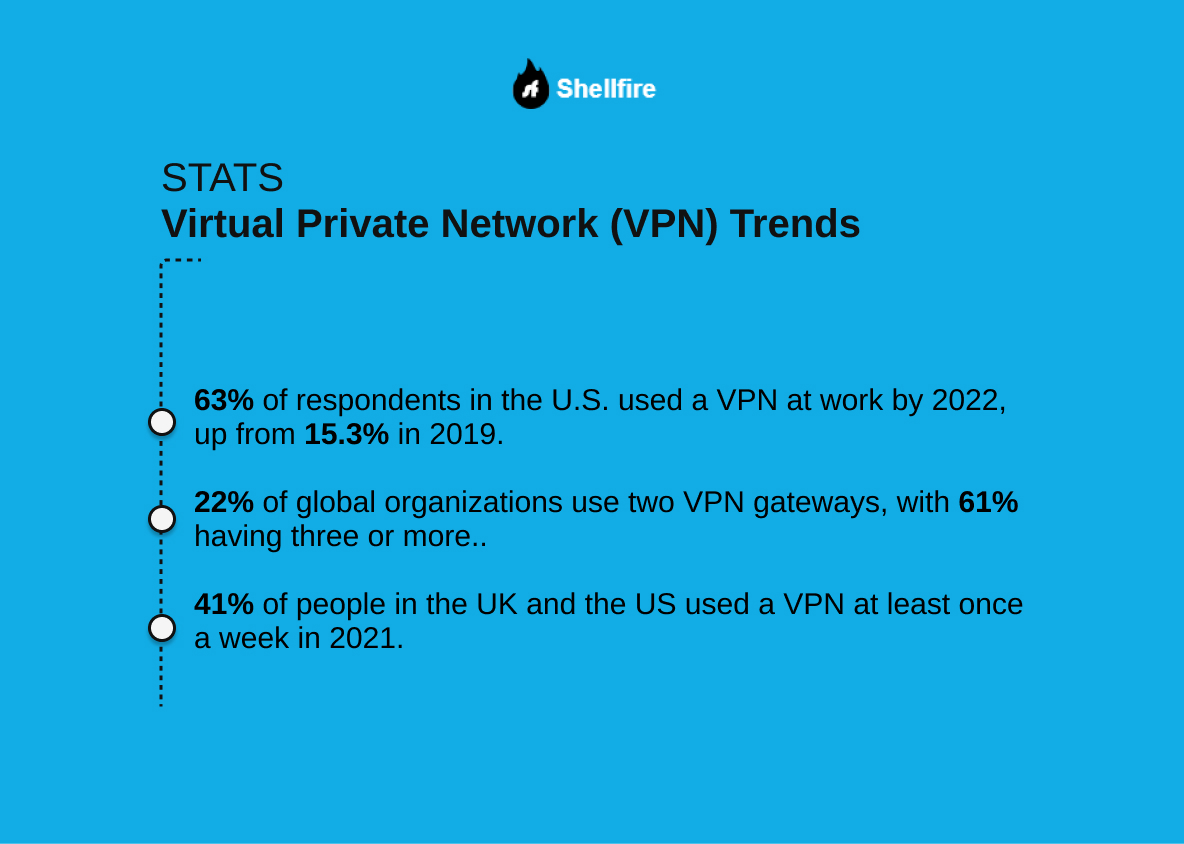Virtual Private Network (VPN) Statistics and Their Impact
In today’s digitized world, online privacy, security, and unrestricted access have become paramount. Virtual Private Networks (VPNs) have risen to the challenge, offering users a shield against potential cyber threats and a bridge over geo-restrictions. The past few years, particularly post-2019, have seen a remarkable surge in VPN usage, driven by a combination of political events, shifts in remote work culture, and the general public’s heightened awareness of online privacy.
This article delves into key VPN usage statistics, exploring the factors driving their adoption and the evolving patterns across different regions and user segments. Whether you’re a digital nomad, a business leader, or just a privacy-conscious individual, these insights will shed light on the increasing significance of VPNs in our interconnected world.
Table of Contents
Key Stats
- 63% of respondents in the U.S. used a VPN at work by 2022, up from 15.3% in 2019.
- 22% of global organizations use two VPN gateways, with 61% having three or more.
- Main reasons for VPN usage in 2022: security, streaming, and privacy.
Virtual Private Network (VPN) Trends: A Deep Dive into Global Usage Patterns

63% of U.S. VPN Usage at Work in 2022.
This marked rise from 15.3% in 2019 signifies more than just numbers. With the onset of global events prompting remote working conditions, the demand for secure online environments has surged.
VPNs offer a secure gateway for professionals, ensuring that sensitive corporate data remains inaccessible to potential threats while accessed remotely (4).
61% of Organizations Have Multiple VPN Gateways.
The fact that 61% of companies operate with three or more VPN gateways underscores the importance of secure and efficient network infrastructures in today’s business world (2). Multiple gateways mean that organizations are prepared for failovers and are likely distributing network load among different servers.
However, this also implies increased IT complexities and the potential for higher operational costs.
Security, Streaming, and Privacy Drive VPN Usage.
VPNs were primarily developed for ensuring data transmission security over unsecured networks. The fact that security remains the top reason for their usage reiterates their fundamental value.
Meanwhile, streaming has emerged as a popular reason because of regional content restrictions imposed by platforms. Privacy, another crucial factor, addresses growing concerns over surveillance and data theft in today’s digital age (3).
Surge in VPN Use for Remote Work in 2020.
The pandemic-driven shift towards remote working saw a significant increase in VPN usage, especially in 2020 and 2021. According to a VPN’s network analysis, users were connected to their VPN for several more hours each day than before.
Furthermore, 41% of people in the UK and the US claimed they used a VPN at least once a week, with 36% of those users using a VPN daily (4).
Asia Leads in VPN Usage with Indonesia at 23%.
The Asia-Pacific region dominates VPN usage with countries like Indonesia leading at 23%, followed by Turkey at 22%, and Vietnam at 20%.
This pronounced VPN usage suggests a demand for unrestricted internet access amidst the varying degrees of internet freedom across these countries.
22% Cite Cost as a Barrier for VPN Adoption in the U.S.
Even with the myriad benefits offered by VPNs, a significant portion of the U.S. population doesn’t find personal relevance in them.
While 22% of respondents mentioned costs as a deterrent, it’s noteworthy that several free VPN options are available, although they might come with their own limitations (7).
India Registers a Whopping 108 Internet Restrictions.
India emerges as a hotspot for digital censorship, primarily due to political protests. This highlights the state of political turbulence and its impact on digital freedoms, making tools like VPNs even more essential for maintaining access to information (8).
Conclusion
The surge in VPN usage over the years, particularly in the U.S., underscores the broader shifts in how people interact with the digital world. From bypassing geo-restrictions to ensuring secure remote work environments, VPNs have become more than just tools—they’re now integral to how many navigate the internet.
As political unrest and the need for digital security continue to rise globally, the relevance of VPNs is unlikely to wane.
Literature
- Statista. Virtual private network (VPN) usage in the United States from 2019 to 2022, by location. Available from: https://www.statista.com/statistics/1291880/vpn-usage-in-the-us/
- Statista. How many different inbound VPN gateways do you have globally? Available from: https://www.statista.com/statistics/1228239/enterprise-vpn-use-numbers/
- Statista. Main reasons for VPN usage worldwide in 2022. Available from: https://www.statista.com/statistics/1343692/worldwide-virtual-private-network-reasons-usage/
- Comparitech. VPN statistics: What the numbers tell us about VPNs. Available from: https://www.comparitech.com/vpn/vpn-statistics/
- Statista. These Nations Use VPNs The Most. Available from: https://www.statista.com/chart/3719/share-of-internet-users-who-use-vpns/
- Statista. Where Do People Use VPNs? Available from: https://www.statista.com/chart/16141/top-vpn-region/
- Statista. Main reasons for not having a Virtual Private Network (VPN) for personal use in the United States in 2022. Available from: https://www.statista.com/statistics/1342704/reasons-vpn-non-usage-united-states/
- Statista. Where the Internet Has Been Restricted. Available from: https://www.statista.com/chart/29962/where-the-internet-has-been-restricted-shutdown/
(Featured Image: 128642936/ 123rf.com)

